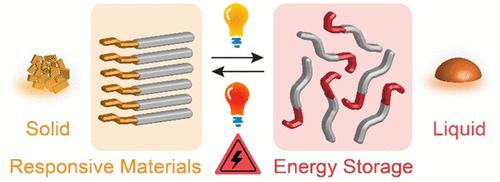当前位置:
X-MOL 学术
›
Acc. Mater. Res.
›
论文详情
Our official English website, www.x-mol.net, welcomes your feedback! (Note: you will need to create a separate account there.)
Stimuli-Responsive Organic Phase Change Materials: Molecular Designs and Applications in Energy Storage
Accounts of Materials Research ( IF 14.6 ) Pub Date : 2022-05-27 , DOI: 10.1021/accountsmr.2c00049 My Le 1 , Grace G. D. Han 1
Accounts of Materials Research ( IF 14.6 ) Pub Date : 2022-05-27 , DOI: 10.1021/accountsmr.2c00049 My Le 1 , Grace G. D. Han 1
Affiliation

|
Achieving a stable latent heat storage over a wide temperature range and a long period of time as well as accomplishing a controlled heat release from conventional phase change materials have remained prominent challenges in thermal energy control. Because the conventional phase change materials have the fixed phase transition temperatures under the standard ambient pressure, the latent heat storage is only viable at temperatures higher than their melting and crystallization points. Once the latent heat is stored in the liquid phase of materials, it is imperative to maintain the temperature of the system above its crystallization point to prolong the heat storage. Without the continuous energy input or extensive insulation, the crystallization of liquid occurs spontaneously, leading to the loss of latent heat and a short heat storage time. Thus, there exists a critical need to develop methods that enable the control over the phase transition of materials, unrestricted by the temperature of the surroundings. The successful development of such methods and materials in recent years has been viable through the incorporation of molecular switches that respond to external stimuli, notably light, electrochemical bias, and ions, by reversible structural changes. We have discovered novel functional organic material systems that exhibit solid-to-liquid phase transitions controlled by optical and electrical stimulation, along with other research groups. The development and optimization of such materials are enabled by the judicious molecular designs and syntheses.
中文翻译:

刺激响应有机相变材料:分子设计和储能应用
在宽温度范围和长时间内实现稳定的潜热存储以及从传统相变材料中实现受控的热释放仍然是热能控制的突出挑战。由于常规相变材料在标准环境压力下具有固定的相变温度,因此潜热储存仅在高于其熔点和结晶点的温度下才可行。一旦潜热储存在材料的液相中,就必须将系统的温度保持在其结晶点以上以延长蓄热时间。如果没有持续的能量输入或广泛的绝缘,液体会自发结晶,导致潜热损失和储热时间短。因此,迫切需要开发能够控制材料相变而不受环境温度限制的方法。近年来,此类方法和材料的成功开发通过结合分子开关来实现,这些开关通过可逆的结构变化来响应外部刺激,特别是光、电化学偏置和离子。我们与其他研究小组一起发现了新的功能性有机材料系统,这些系统表现出由光和电刺激控制的固液相变。明智的分子设计和合成使此类材料的开发和优化成为可能。不受周围温度的限制。近年来,此类方法和材料的成功开发通过结合分子开关来实现,这些开关通过可逆的结构变化来响应外部刺激,特别是光、电化学偏置和离子。我们与其他研究小组一起发现了新的功能性有机材料系统,这些系统表现出由光和电刺激控制的固液相变。明智的分子设计和合成使此类材料的开发和优化成为可能。不受周围温度的限制。近年来,此类方法和材料的成功开发通过结合分子开关来实现,这些开关通过可逆的结构变化来响应外部刺激,特别是光、电化学偏置和离子。我们与其他研究小组一起发现了新的功能性有机材料系统,这些系统表现出由光和电刺激控制的固液相变。明智的分子设计和合成使此类材料的开发和优化成为可能。通过可逆的结构变化。我们与其他研究小组一起发现了新的功能性有机材料系统,这些系统表现出由光和电刺激控制的固液相变。明智的分子设计和合成使此类材料的开发和优化成为可能。通过可逆的结构变化。我们与其他研究小组一起发现了新的功能性有机材料系统,这些系统表现出由光和电刺激控制的固液相变。明智的分子设计和合成使此类材料的开发和优化成为可能。
更新日期:2022-05-27
中文翻译:

刺激响应有机相变材料:分子设计和储能应用
在宽温度范围和长时间内实现稳定的潜热存储以及从传统相变材料中实现受控的热释放仍然是热能控制的突出挑战。由于常规相变材料在标准环境压力下具有固定的相变温度,因此潜热储存仅在高于其熔点和结晶点的温度下才可行。一旦潜热储存在材料的液相中,就必须将系统的温度保持在其结晶点以上以延长蓄热时间。如果没有持续的能量输入或广泛的绝缘,液体会自发结晶,导致潜热损失和储热时间短。因此,迫切需要开发能够控制材料相变而不受环境温度限制的方法。近年来,此类方法和材料的成功开发通过结合分子开关来实现,这些开关通过可逆的结构变化来响应外部刺激,特别是光、电化学偏置和离子。我们与其他研究小组一起发现了新的功能性有机材料系统,这些系统表现出由光和电刺激控制的固液相变。明智的分子设计和合成使此类材料的开发和优化成为可能。不受周围温度的限制。近年来,此类方法和材料的成功开发通过结合分子开关来实现,这些开关通过可逆的结构变化来响应外部刺激,特别是光、电化学偏置和离子。我们与其他研究小组一起发现了新的功能性有机材料系统,这些系统表现出由光和电刺激控制的固液相变。明智的分子设计和合成使此类材料的开发和优化成为可能。不受周围温度的限制。近年来,此类方法和材料的成功开发通过结合分子开关来实现,这些开关通过可逆的结构变化来响应外部刺激,特别是光、电化学偏置和离子。我们与其他研究小组一起发现了新的功能性有机材料系统,这些系统表现出由光和电刺激控制的固液相变。明智的分子设计和合成使此类材料的开发和优化成为可能。通过可逆的结构变化。我们与其他研究小组一起发现了新的功能性有机材料系统,这些系统表现出由光和电刺激控制的固液相变。明智的分子设计和合成使此类材料的开发和优化成为可能。通过可逆的结构变化。我们与其他研究小组一起发现了新的功能性有机材料系统,这些系统表现出由光和电刺激控制的固液相变。明智的分子设计和合成使此类材料的开发和优化成为可能。



























 京公网安备 11010802027423号
京公网安备 11010802027423号